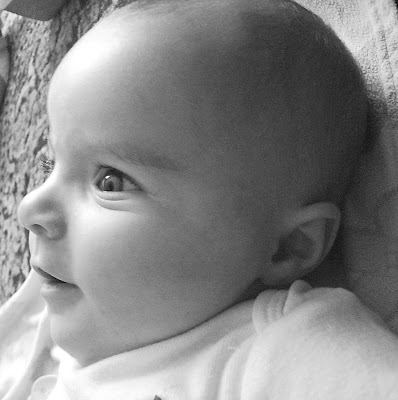First of all, I called the St. Louis Children's Hospital to get some more information about whether Addy could be accepted as a candidate for endoscopic surgery at their facility. The receptionist talked to the doctor there, and told me that while in the past they have corrected cases of coronal synostosis using the endoscopic procedure, they were "not excited" about the outcome. Meaning, the results didn't look as good and the head shape did not correct itself as nicely. (I asked if this meant they had problems with the sutures closing up again, and she said that did not normally happen.)
Apparently, most of the surgeries that are performed endoscopically in St. Louis deal with saggital synostosis, which is when the bones fuse together down the middle of the head. (Saggital synostosis is the most common type, making up about 50-60% of cases, while coronal is the second most common with 20-30%.) The receptionist told me that the doctor would be willing to consider performing the surgery on Addy, but we would have to go into it with the understanding that she might need further correction down the road.
With that in mind, I tried contacting the University Health System in San Antonio. In my searches for doctors who perform this surgery, this facility was the first thing that came up. I didn't try them first only because their location is significantly further away. Apparently, though, these people are the pioneers of endoscopic treatment of craniosynostosis, and the lady who answered my questions there gave me the impression that they do only endoscopic repairs. (I forgot to ask for complete clarification on that point.)
Besides these factors, I was also impressed by the fact that, even though I contacted them by email instead of by phone, the nurse there called me back within about a half an hour of my email. She was very helpful in answering my questions, and she sent me an email with more information soon after we got off the phone. It also doesn't hurt that they have a video on their website showing Addy's exact condition and explaining how they treat it, plus a whole series of before and after photos for coronal synostosis patients!
Obviously, this facility does routinely perform endoscopic surgery on coronal synostosis patients. The nurse there told me that they have had good results with these surgeries, but emphasized that they are very dependent on helmet therapy following the procedure. Apparently this would involve Addy wearing these helmets until she was 12-18 months old, getting new helmets 4-6 times within that period to adjust for her growth. The nurse also emphasized that we would have to return to San Antonio for these helmets and not get them done somewhere else, because (as she said), "other places do it wrong." That could explain why the people in St. Louis have not seen good results, if they do not do the helmet therapy correctly.
So, we are still going to meet with the surgeon at Duke on Thursday. Unless he gives us a good reason to pursue the traditional "open" treatment, however, we will most likely see if we can get Addy accepted to the place in San Antonio. We are definitely liking what we are seeing there, and although the distance is further, it sounds worth it, especially since it seems advantageous to get this issue fixed as soon as possible. I asked the nurse in San Antonio whether she could tell me the risks of waiting for the open procedure, and she said she could not tell me specifically, except that the brain would continue to grow and skew the head shape even further the longer we wait. That will be one question on which we can hopefully get more clarification on Thursday.
Please pray that we will get all the information we need to decide which method of surgery would be best for Addy. Please also pray that we would get accepted to San Antonio if that is the route we choose, and that God would work out the logistics of getting us there for the surgery and follow-ups.
Thanks!












